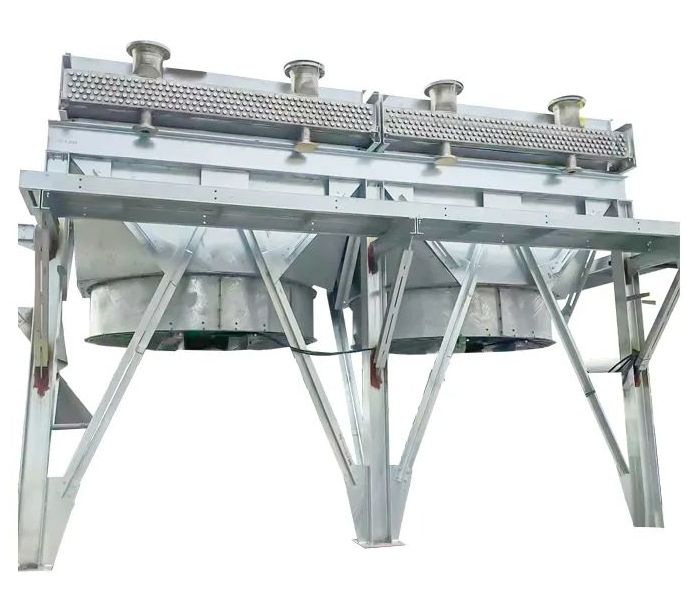- Tel: 0086-21-35324116
- E-mail: sales@shenglincooling.com
Information
Our Fin Fan Cooler is a highly efficient, air-cooled heat exchanger widely used in oil & gas, petrochemical, power generation, and various industrial processes. By leveraging ambient air as the cooling medium, it provides sustainable and cost-effective process cooling without consuming water.
Advantages
● Eco-Friendly: Zero water consumption, no wastewater discharge.
● Cost-Effective: Lower operational and maintenance costs vs. water-cooled systems.
● High Adaptability: Performs reliably in extreme temperatures and harsh conditions.
● Compact Design: Modular structure for space-saving installations.
● Long Lifespan: Corrosion-resistant materials and robust engineering.
Applications
● Oil & Gas: Cooling refinery streams, natural gas, and LNG.
● Power Generation: Condensing steam turbines and cooling auxiliary systems.
● Chemical Industry: Managing exothermic reactions and vapor condensation.
● Renewable Energy: Supporting geothermal and biomass energy systems.
● HVAC & Manufacturing: Industrial heat recovery and process cooling.
Optional Configurations
● Compliance with ASME and API 661 standards
● Forced Draft or Induced Draft fan arrangements
● Horizontal or Vertical air flow design
● Smart Controls (temperature sensors, variable speed fans)
● Explosion-Proof, Low-Noise, or Marine-Grade Designs
● Dry/Wet Hybrid System for Enhanced Performance in high ambient temperatures
● Custom painting & corrosion protection
Extended Surface Fin Types Available
● L-foot fin (basic embedded fin, economical and widely used for general-purpose cooling)
● Overlapped L-foot fin (LL type): provides better corrosion resistance by overlapping fin foot over the tube surface
● Embedded G-fin: fins mechanically embedded into the tube surface for improved thermal contact and durability
● Knurled L-foot fin (KL type): uses a knurled surface on the tube to enhance mechanical bonding between fin and tube
● Extruded fin: formed by extruding aluminum over the tube for maximum corrosion resistance and strength, ideal for harsh environments
● Bimetallic finned tubes: e.g., aluminum fins on carbon steel or stainless steel tubes, combining thermal conductivity with structural or corrosion benefits
● Custom fin materials and geometries available upon request
Header Types Available
● Plug-type header (for compact or low-cost design)
● Removable cover plate header (for easy inspection and maintenance)
● Removable bonnet-type header (for higher-pressure applications with external access)
● Manifold-type header (for multi-pass or special flow arrangements)

Country: Thailand

Country: China

Country: the Philippines

Country: China
Caterpillar Engine

Country: Oman

Country: Russia

Country: USA
Main Material: Carbon Steel Tube /Alu. Fins

Country: Sri Lanka

Air-Cooled vs. Water-Cooled Heat Exchangers
Which One to Choose?
● Air-cooled systems are recommended for water-scarce or high-temperature regions, offering low maintenance costs and zero water consumption.
● Water-cooled shell-and-tube exchangers are ideal when lower outlet temperatures, compact installation, or reliable water supply are required.
● We also offer hybrid (dry/wet) air-cooled systems for enhanced performance in hot climates.
Supporting Products:

● Air Fin Cooler / Dry Cooler
● Shell and Tube Heat Exchanger
● Plate Heat Exchanger
● Hybrid Cooling Systems (Dry + Spray)
Air-Cooled Heat Exchangers (Dry Coolers, Air Fin Coolers)
Advantages
● Environmentally friendly: no water consumption, no thermal or chemical pollution
● Site flexibility: suitable for arid areas or water-scarce regions
● Easy maintenance: corrosion-free, scaling-free, long service life
● Lower operating costs: air has low resistance and no treatment cost
● Passive cooling: retains 30–40% natural cooling even when power is off
Limitations
● Cooling is limited by dry-bulb temperature; it cannot cool below ambient
● Requires a larger footprint due to low air-side heat transfer
● Affected by weather: wind, sunlight, and seasonal changes impact performance
● Noise: due to fans and airflow
● Requires finned tubes and specialized fan systems
Shell-and-Tube Water-Cooled Heat Exchangers
Advantages
● High cooling efficiency: outlet temperature can approach wet-bulb conditions
● Compact design: smaller footprint, easily integrated into tight spaces
● Stable performance: unaffected by ambient temperature fluctuations

● Quiet operation: no fans, minimal noise
Limitations
● High water consumption and pollution risk
● Needs water source, pumps, pipelines, and treatment systems
● Corrosion & scaling: frequent maintenance and chemical treatment required
● Total shutdown upon power failure
● Biological growth risk in warm climates








